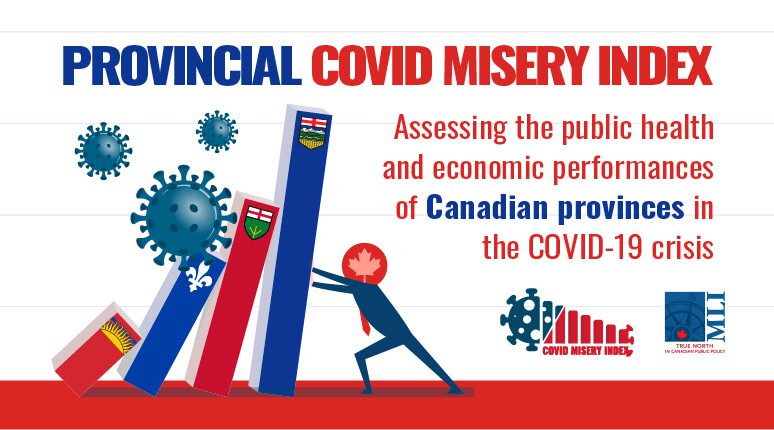 OTTAWA, ON (July 19, 2021): Even as Canada’s vaccine picture improves by the day and COVID-19 cases and deaths dwindle, the pace of various provinces moving beyond lockdown measures has been extremely uneven.
OTTAWA, ON (July 19, 2021): Even as Canada’s vaccine picture improves by the day and COVID-19 cases and deaths dwindle, the pace of various provinces moving beyond lockdown measures has been extremely uneven.
MLI’s Provincial COVID Misery Index (PCMI), updated today, reveals that while Ontario is in a statistical tie for the best vaccination record of all provinces, and despite a steadily improving picture in terms of COVID-19 cases, hospitalizations, and deaths, it has been by far the strictest jurisdiction in Canada in terms of lockdowns and restrictions on personal freedoms.
Check out the full, interactive Provincial COVID Misery Index here, or read the analysis of the most recent data here.
The province has only just moved into its “phase 3” re-opening, which still preserves many restrictions and public health measures. Over the course of the pandemic, and in recent weeks, Ontario has remained a significant outlier compared to its peers in terms of the metric of lockdown “stringency,” which includes such measures as stay-at-home orders, limits on gatherings, business and school closures, curfews and quarantines.
The PCMI is a comprehensive tool designed to compare the impacts of the pandemic and governments’ responses to it on Canadians’ wellbeing. It captures the health impacts wrought by the disease itself such as cases and deaths (Disease Misery), the efficiency of provinces’ responses such as vaccination and testing programs (Response Misery), and the economic toll endured in terms of lost jobs, rising debt levels and lost economic growth (Economic Misery). Disease and Response Misery have been updated to reflect the most recent data, whereas Economic Misery is updated less frequently due to lags in data reporting.
With these measures taken together, we see that Atlantic Canada continues to outperform the rest of the country in the rankings, with Prince Edward Island leading the pack, followed closely by Nova Scotia and New Brunswick. Newfoundland and Labrador remain at the bottom of the Atlantic provinces, followed closely by Manitoba, which has risen to 5th place.
“Atlantic Canada’s success over the course of the pandemic is unassailable,” says MLI Senior Fellow and PCMI architect, Richard Audas. “By preventing the disease from making major inroads, the Atlantic provinces have, for the most part, managed to protect the health of their citizens and the strength of their economies without relying so heavily on the harsh lockdown measures which defined much of continental Canada.”
Despite continuing to lag somewhat on vaccine distribution, the Atlantic provinces have succeeded in balancing COVID-19 priorities – effectively the opposite experience as that of Ontario, Quebec, and Alberta. As Audas notes, this success appears to be driven “by some combination of acting quickly, a compliant public, no international flight arrivals, low population density and the plain luck of island geography.”
The Western provinces – especially Alberta, which remains at the bottom of the PCMI – continue to rank comparatively poorly. Caseloads, deaths attributed to COVID-19, and excess deaths are generally above the Canadian average. While the most stringent public health measures are being relaxed, vaccination rates in Saskatchewan, Alberta and British Columbia remain below the Canadian average. However, it should be noted that Manitoba stands out as having the highest vaccination rate of any province.
“Barring a major resurgence of COVID-19, we anticipate that Alberta’s early reopening will lead to some improvement in its overall score,” says Audas. “As commodities recover, Alberta’s Economic Misery is expected to improve further.”
Audas notes that while COVID-19 misery across Canada is definitely on the decline, it will take a while for recent successes in moving beyond lockdowns, lower case counts and rebounding economies to significantly change the overall PCMI rankings, which reflect provinces’ experience over the whole course of the pandemic. The economic damage, physical and mental health effects, excesses deaths, and the pressure of COVID-19 on the health system will likely be felt for years to come.
“A business owner whose livelihood failed last year or a person whose loved one passed away might take little solace in the fact that it seems the worst is over,” argues Audas. “For most, 15 months worth of misery endured by Canadians can’t be made up for by one or two month variations in reopening schedules.”
Yet, with vaccination rates continuing to increase across the country, serving as a rising immunity wall to help mitigate the full impact of the spread of virus variants, much of the country looks poised to finally get back to something that looks like normal – at least for the rest of the summer. If vaccines continue to do their job and lockdown measures are removed, we can anticipate significant benefits for the economy and the health and wellbeing of citizens in the longer-term.
For more information, consult the links below.
- Check out the Provincial COVID Misery Index here.
- Read the written analysis and full methodology here.
- Download the data for yourself using this link.
- Consult the national-level comparison here.
Additionally, media are invited to contact:
Brett Byers
Communications and Digital Media Manager
613-482-8327 x105
brett.byers@macdonaldlaurier.ca




